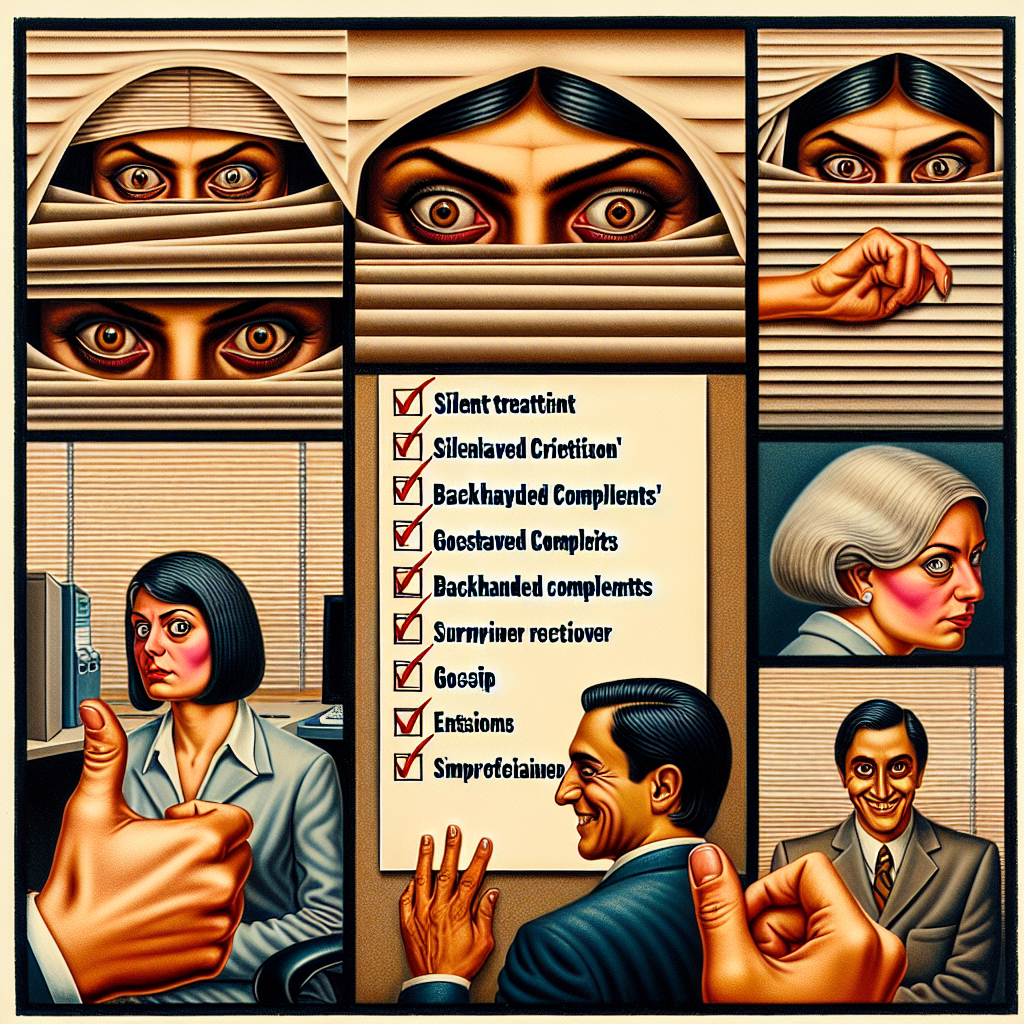Top 10 Shocking Signs: How to Spot and Manage Passive Aggressive Behaviors in the Workplace

Introduction
Defining Passive Aggressive Behavior
Passive aggressive behavior involves indirect resistance to the demands or requests of others. In the workplace, it manifests through subtle actions that communicate negative feelings, such as procrastination, sarcasm, and deliberate inefficiency. These behaviors can create a toxic environment, damaging team morale and productivity.
Importance of Identifying Passive Aggression
Identifying passive aggressive behaviors is crucial because they can hinder teamwork and affect the overall productivity of the organization. Addressing these behaviors promptly ensures a healthy work environment where open communication and collaboration thrive.
Overview of the Article
This article will explore the signs of passive aggressive behaviors in the workplace and provide strategies for managing them. By understanding these signs, you can foster a more positive and productive work environment.
Understanding Passive Aggressive Behaviors
What is Passive Aggression?
Passive aggression is a type of behavior characterized by indirect resistance and avoidance of direct confrontation. It is expressed through actions rather than words, often leaving the recipient feeling confused and frustrated.
Behavioral Characteristics
- Sarcasm and backhanded compliments
- Avoidance and procrastination
- Deliberate inefficiency
- Frequent complaints and pessimism
Common Triggers
Passive aggressive behaviors can be triggered by:
- Perceived injustice or unfair treatment
- Lack of recognition or appreciation
- Feeling overwhelmed or overburdened
- Inability to express feelings openly
Psychological Roots
The root causes of passive aggressive behavior often lie in early life experiences and personality traits. People who exhibit this behavior may have learned to avoid direct confrontation as a coping mechanism.
Impact on Workplace Dynamics
Team Morale
Passive aggression can significantly undermine team morale, leading to decreased job satisfaction and increased stress among team members.
Productivity and Efficiency
When passive aggressive behaviors are prevalent, tasks take longer to complete, and the overall efficiency of the team suffers.
Interpersonal Relationships
Trust and respect among colleagues are eroded, leading to strained relationships and a hostile work environment.
Examples in Daily Interactions
Communication Issues
- Sarcastic remarks: "Oh, you're actually on time today!"
- Backhanded compliments: "You did well for a change."
- Evasive responses: "I'll get to it when I can."
Work Avoidance
- Procrastination: Deliberately delaying tasks to frustrate colleagues or superiors.
- Inefficiency: Performing tasks poorly to avoid future responsibilities.
Conflict Escalation
Passive aggressive behavior can lead to escalating conflicts, as unresolved issues pile up over time.
Non-Verbal Cues
Body Language
- Eye-rolling and sighing
- Crossed arms
- Avoiding eye contact
Facial Expressions
- Forced smiles
- Raised eyebrows
Silence
- Using the silent treatment
- Ignoring colleagues
Verbal Indications
Sarcasm and Irony
Using sarcasm to express frustration: "Great, another meeting."
Backhanded Compliments
Compliments that are actually criticisms: "You're surprisingly good at this for someone with your background."
Vague Responses
Ambiguous answers to avoid commitments: "I'll see what I can do."
Behavioral Patterns
Procrastination
Intentionally delaying tasks: Missing deadlines as a form of silent protest.
Deliberate Inefficiency
Performing tasks poorly to avoid future duties.
Chronically Negative Attitudes
Consistently pessimistic outlook that demoralizes the team.
Managing Passive Aggressive Behaviors
Immediate Responses
Addressing Behavior Directly
Confront passive aggressive behaviors respectfully and constructively, focusing on specific actions and their impact.
Open Communication
Foster a culture of open and honest dialogue to prevent passive aggressive behaviors.
Setting Clear Expectations
Establish and communicate clear expectations and consequences for passive aggressive behaviors.
Long-term Strategies
Conflict Resolution Training
Implement training programs to equip employees with skills to resolve conflicts effectively.
Creating a Supportive Environment
Encourage a supportive workplace culture, where employees feel valued and respected.
Regular Feedback Sessions
Institute regular feedback sessions to address issues before they escalate.
Professional Help
Involving Human Resources
Involve HR when passive aggressive behaviors persist despite initial interventions.
Mediation Services
Utilize mediation services for particularly challenging situations.
Counseling and Therapy Options
Provide access to professional counseling for employees displaying or affected by passive aggressive behaviors.
Prevention Strategies
Promoting Positive Communication
Encouraging Assertiveness
Train employees to express themselves assertively rather than passively or aggressively.
Active Listening Skills
Promote active listening to enhance understanding and reduce misunderstandings.
Constructive Feedback
Teach employees to give and receive feedback in a constructive manner.
Building Trust and Transparency
Team-Building Activities
Conduct activities that strengthen trust and collaboration among team members.
Transparent Policies
Maintain clear and transparent workplace policies to prevent passive aggression.
Leadership by Example
Encourage leaders to model transparent and honest communication.
Regular Monitoring and Review
Employee Surveys
Implement regular surveys to gauge workplace climate and detect early signs of passive aggression.
Performance Reviews
Use performance reviews to address and rectify any passive aggressive behaviors.
Continuous Improvement Programs
Establish programs aimed at continuously improving workplace relations and behavior.
Conclusion
Recap of Key Points
Summary of Passive Aggressive Signs
Review the top ten signs of passive aggressive behavior, including body language, sarcasm, procrastination, and chronic negativity.
Summary of Management Strategies
Overview of immediate responses, long-term strategies, professional help, and prevention methods.
Final Thoughts
Importance of Addressing the Issue
Addressing passive aggressive behavior is essential for maintaining a healthy and productive workplace.
Encouraging a Proactive Approach
Proactive measures are crucial in preventing and managing passive aggression.
Frequently Asked Questions (FAQs)
Common Questions and Answers
How can I tell if someone is being passive aggressive or just having a bad day?
Differentiate occasional frustration from consistent passive aggressive behavior by observing patterns over time.
What should I do if my manager is passive aggressive?
Address the behavior professionally, seek support from HR, and consider mediation services if necessary.
Can passive aggressive behavior be a sign of a deeper issue?
Yes, passive aggression can indicate underlying personal or professional problems that may require further attention.
How can I change my own passive aggressive habits?
Recognize your behavior, seek feedback, and engage in conflict resolution training or counseling.
Is there a way to measure the impact of passive aggression on productivity?
Employee surveys, performance reviews, and productivity metrics can help assess the impact of passive aggression on workplace efficiency and morale.

